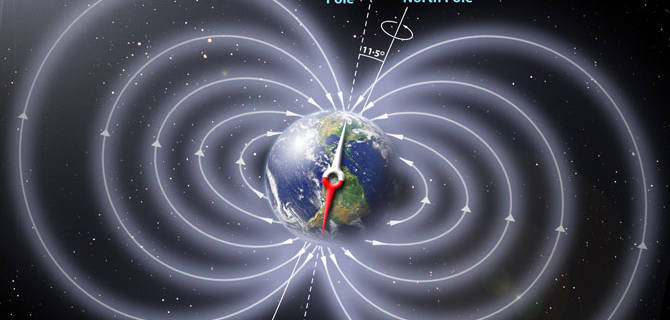The Earth – A Huge Magnet
Geomagnetism is the study of the earth’s magnetic behavior. Earth is a giant bar magnet. The geomagnetic field is the magnetic field of the earth. The dipolar origin of this field is inside Earth. From the earth, it extends to outer space, interacting with charged atoms from the sun. There are various sources of the earth’s magnetic field. A few of these sources include the geomagnetic dynamo, the ionospheric dynamo, the ring current, the tail current, magnetopause current, and field current. Amongst these sources, the geomagnetic source stands out as the most relevant. This is because the other sources exist due to the field it creates. Notwithstanding, the other sources become as effective as the geomagnetic dynamo above the earth’s surface.
Variations of the Magnetic Field of the Earth
The geomagnetic field can be quite variable. The various sources of the geomagnetic field are responsible for these variations when they are disturbed. Here are how some of the sources of the earth’s magnetic field may be disturbed:
- Seasonal and Solar Cycle: this majorly affects the ionospheric dynamo.
- Solar Wind: it is known to affect the ring current. The magnetic field becomes stronger under suitable solar wind conditions.
- Magnetospheric Substorm: changes in this also disturb the ring current.
- Magnetohydrodynamic waves also contribute to the variations of the magnetic field. These waves represent changes in magnetic and electrical fields associated with changes in particle density. They convey information about variations in electric current within the earth and its environs.
Sources of the Earth’s Magnetic Field
- Earth’s Core: the earth’s core generates a magnetic field via electric currents. The fluidity and high temperature of the earth’s core are responsible for the electric current.
- Mantle: some may think that the mantle cannot sustain magnetic current because of its temperature. However, like all other semiconductors, its electrical conductivity is directly proportional to temperature. The electrical current it conducts sustains its magnetic field. Lithosphere: the temperature of the superior portion of the lithosphere is cool. This cool temperature allows the magnetic force to be sustained.
- Ocean Current: the movement of sea-water causes a dynamo effect. This generates and distributes electrical current. In addition, seawater is a good electrical conductor. These factors are responsible for the role of ocean current as a source of the magnetic field of the earth.
- Ionospheric Dynamo: there is a portion of the ionosphere known as the E region. The equilibrium between the decreasing strength of incoming radiation with lower height and the increasing density of the atoms with lower height is responsible for the formation of the E region. The E region is essential for the dynamics of the magnetic field. Solar heating of the atmosphere, as well as the sun’s gravity, contributes to the ionospheric dynamo.
- Ring-current: it is an essential magnetospheric current system. Almost all atoms present in this region are ionized. In addition, the atoms have a low density. The magnetic field formed by the ring current is almost over the earth’s surface.
- The Magnetopause Current: this current demarcates the magnetic field of the earth from the solar wind. The field of the current from this source decreases the field outside the demarcation and raises it inside.
- The Magnetotail Current: it has the same direction as the ring current throughout the day. The same mechanism produces it as the ring current. It is also similar to the magnetopause current. However, it courses inside the magnetic field of the earth.
- Field-aligned Current System: It comprises two fields with opposite and parallel current sheets.

The Earth’s Magnet Field Source: nasa.gov
Measurement of the Geomagnetic Field
Although the earth’s magnetic field exists, it cannot be sensed unless it is measured. The earth’s magnetic field can be measured in a substantial number of ways. Compass: this is the oldest and most widely known instrument for measuring the earth’s magnetic field or any magnetic field for that matter. When there is a magnetic field, the magnetized needle present in the compass aligns itself in the direction of the magnetic field. The oscillations of the compass needle are used to measure the magnetic field. Proton-precession Magnetometer: This instrument measures the earth’s magnetic field accurately because of the magnetic and gyroscopic features of protons in a fluid. It is used chiefly for measurements near the earth’s surface. Fluxgate Magnetometer: it is mainly used in spaceships. It can be used in a spaceship only when the location and orientation of the spaceship relative to the earth is known. Further Reading: How to Determine North And South Pole of Magnet?
Significance of Earth’s Magnetic Field
- It protects the earth from radioactive emissions from the sun that can destroy the ozone layer.
- It influences the navigation of a compass.
Further Reading: Effects of Earth’s Magnetic Field on Birds
Characteristics of the Magnetic Field of the Earth
- The intensity is not equal across the earth. It is more intense at the poles than at the equator.
- Magnetic field lines enter the earth at the north pole and leave at the south pole.
- The axis of the magnetic pole differs from the geographical axis.
Conclusion
Thank you for reading our article and we hope it can help you to better understand why the earth is a huge magnet. If you want to know more about magnets, we advise you to visit Stanford Magnets for more information.














